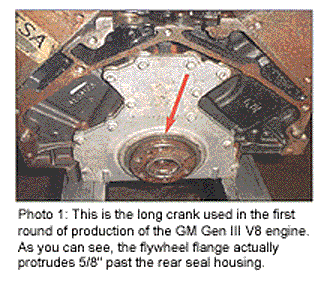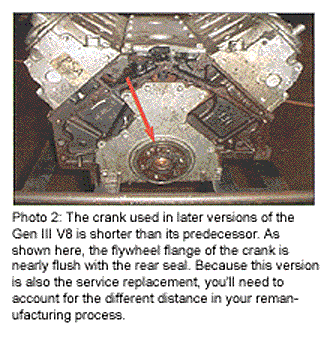Some months back (December 2003 Engine Builder, to be exact), I wrote about some of the identification features of the Gen III GM V8 engines. Considering that the Gen IV with DOD (Displacement on Demand) is about to be released, this is probably a good time to go over a few other things that you will have to know about GM’s staple engine(s).

The first thing that seems to throw most people into a tailspin is the fact that these engines had two different crank lengths and flywheel/flexplate configurations. There was a long crank and a short crank. The long crank (photo 1) was used in the first round of production and the short crank (photo 2) went in to current production as well as the service replacement. This means you cannot purchase a new long crank from GM. The difference between the long and short crank is 3 mm at the rear of the crank. So the distance between the rear thrust flange surface to the flywheel flange is the dimension that changes.

The 6.0L engine RPO LQ4 had the long crankshaft in MY 2000 and went home months back (December 2003 Engine Builder, to be exact), I wrote about some of the identification features of the Gen III GM V8 engines. Considering that the Gen IV with DOD (Displacement on Demand) is about to be released, this is probably a good time to go over a few other things that you will have to know about GM’s staple engine(s).
The first thing that seems to throw most people into a tailspin is the fact that these engines had two different crank lengths and flywheel/flexplate configurations. There was a long crank and a short crank. The long crank (photo 1) was used in the first round of production and the short crank (photo 2) went into current production as well as the service replacement. This means you cannot purchase a new long crank from GM. The difference between the long and short crank is 3 mm at the rear of the crank. So the distance between the rear thrust flange surface to the flywheel flange is the dimension that changes.
The 6.0L engine RPO LQ4 had the long crankshaft in MY 2000 and went to the short crank in MY 2001 through current model year in both manual and automatic applications. The 5.3L engine RPO LM7 had the short crank in all applications. This engine was always in front of an automatic transmission. In fact, you can use this as an identifier between the 4.8L and 5.3L since they look identical as long blocks (see previous article).
The difference is that only 4.8L engines use both manual and automatic transmissions. If you see the block identifier of 4.8 and 5.3 on the block and the crankshaft has a pilot bearing it is a 4.8L. The 4.8L used the short crank exclusively as well in all of the automatic applications but the long crank for MY2000 manual transmission applications and the short crank for MY 2001 through current on those same applications.
Now, if – and this is important – you are replacing a long crank with a short crank, you need to use the 3mm spacer and bolts. The part number for the spacer is 12563532 for one, and the bolts are p/n 12563533 – you’ll need six of them. You will only need this spacer if you are using the flywheel or flexplate for the original long crankshaft. If you’re going to use the updated flywheel or flexplate you will NOT use the spacer. Do not get this mixed up because it will not work.
A running change that occurred on these engines concerns connecting rods. Although a clear definition of when it happened is not readily available, you will still want to know about it. GM went from a press fit connecting rod to a full floating one with a bushing. The rods are interchangeable in sets only: “Do not mix them up!” is the way it was explained to me.
The other change that occurred as a running change in December of 2003 was a change in the OD of the cam bearings. Number 3 stayed the same; No.’s 2 and 4 positions are .5 mm larger and the No. 1 and No. 5 positions are 1.0 mm larger. The ID and the camshaft main journals stayed the same. This change was strictly an ease of installation situation on the production line; however, you can see how you had better make certain that you use the correct cam bearing set.
Lastly – and this happened as a running change in 2004 – the head bolts went from 160 mm in length to 100 mm. Notice that these have all been running changes which means that casting numbers did not change, so you better know what you have when you build these engines.
I hope these tidbits keep you out of the “do over” column and allow
you to continue to stay ahead of the curve with “Tomorrow’s Solutions Today.” As professional engine remanufacturers, we need to continue to bond together and help each other with the sharing of technology and information. For more information of this caliber, visit www.engineDataSource.com.













